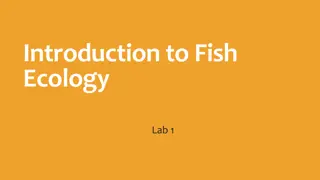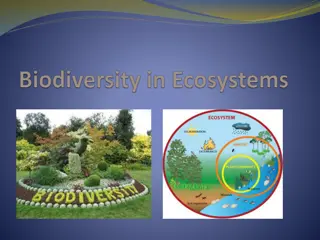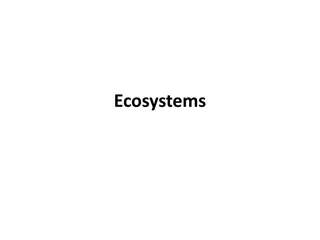Understanding Ecosystems: Components and Interactions
Ecosystems are dynamic systems where abiotic and biotic components interact to sustain life. Ecology studies these interactions, including nutrient cycling and energy flow. The biosphere, comprising the atmosphere, hydrosphere, lithosphere, and living organisms, forms Earth's life-support system. Ecosystems depend on the intricate balance of nature for sustaining life.
Download Presentation

Please find below an Image/Link to download the presentation.
The content on the website is provided AS IS for your information and personal use only. It may not be sold, licensed, or shared on other websites without obtaining consent from the author. Download presentation by click this link. If you encounter any issues during the download, it is possible that the publisher has removed the file from their server.
E N D
Presentation Transcript
Ecosystems: What are They and How Do They Work?
What is Ecology? It is the study of how organisms interact with each other. All living things are composed of cells.
Ecologists Study Connections in Nature. Biosphere Ecosystem Community Population Organism Cell Molecule Atom
What Keeps us and Other Organisms Alive? Life is sustained by the flow of energy from the sun through the biosphere, the cycling of nutrients within the biosphere, and gravity.
4 major components of Earths Life- Support System
The Lithosphere the rigid outer part of the earth, consisting of the crust and upper mantle
The Biosphere The Biosphere consists of parts of earth s water, air, and soil where living organisms are found. It is the global ecosystem in which all organisms exist can interact with one another.
Ecosystems have Abiotic and Biotic Components ABIOTIC NONLIVING BIOTIC LIVING WATER AIR NUTRIENTS ROCKS HEAT SOLAR ENERGY PLANTS ANIMALS BIRDS MICROBES DEAD ORGANIC MATTER ORGANIC WASTE These are just a few. There are others.
Ecosystems depend on Nutrient Cycling Nitrogen, Phosphorus, Carbon, and Sulfur are major nutrients for living organisms. Decomposers such as bacteria and fungi are the final link to breaking down these nutrients. There is very little waste of nutrients in nature. Only a small percentage of the large amounts of waste that humans produce is recycled.
Energy in Ecosystems begins with aerobic or anaerobic respiration AEROBIC Respiration Glucose + Oxygen Carbon Dioxide + Water + Energy C6H12O6 + 6 O2 6 CO2 + 6 H2O + Energy ANAEROBIC Respiration Breakdown of glucose or other organic compounds in the absence of oxygen. Produces compounds like methane, ethyl alcohol, acetic acid, and hydrogen sulfide Glucose Ethanol + Carbon dioxide C6H12O6 (aq) 2 CH3CH2OH (aq) + 2 CO2(g)
Range of Tolerance Populations in an ecosystem have a range of tolerance to variations in their physical and chemical environment. Any direction outside of the range of tolerance can put strain on the population and eventually kill the population. Abiotic factors such as shade, sunlight, temperature, and moisture will affect range of tolerance.
Limiting Factor Principle Too much or too little of any abiotic factor can limit or prevent growth of a population, even if all other factors are at or near the optimal range of tolerance. On land, precipitation often is the limiting abiotic factor. Soil nutrients are also limiting factors. Too much of an abiotic factor (water or fertilizer) can be a limiting. Temperature can also be limiting too high or too low temps affect growth. Aquatic limiting factors include temperature, sunlight, nutrient availability, dissolved oxygen, and salinity.
Ecology Terminology 1 make sure you can define, explain, and give examples of all these terms Cell Theory Species Prokaryotic cell Eukaryotic cell Genetic Diversity Trophic Level Autotroph Chemotroph Heterotroph Chemosynthesis Photosynthesis Omnivores Detritus
Energy flows through Ecosystems in Food Chains and Food Webs (10% rule)
Ecology Terminology 2 Detritivores Decomposers Anaerobic Respiration Aerobic Respiration Primary, Seconday, and Tertiary or higher consumers Endotherm Ectotherm Poikilotherm Biomass Ecological Efficiency Pyramid of Energy Flow Gross Primary Productivity (GPP) Net Primary Productivity (NPP)
GPP vs NPP Gross Primary Production the rate at which an ecosystem s producers (usually plants) convert solar energy into chemical energy as biomass found in their tissues Net Primary Production GPP minus the rate at which they use some of this stored energy through cellular respiration.
Sample Energy Calculations 1. A primary producer captures 5,000 units of solar energy. How much energy is available to a tertiary consumer? 5000 x .10 = 500 units for 1st 500 x .10 = 50 units for 2nd 50 x .10 = 5 units for 3rd 2. Applying the 10% rule, if a shrew living in a tropical rainforest has a daily requirement of 500 Cal., how many square meters of rainforest are needed to support one shrew that feeds only on snails which are primary consumers? A. 0.6m2 B. 1.1m2 C. 207.4m2 D. 401.5m2 E. 2073.9m2 1m2 2200g NPP(g/m2/yr) 2,200 Ecosystem Type Tropical rain forest Energy provided to 1 Consumer (Cal/gram) 4 1g .4 Cal 500 Cal = .5682 x 365 207.3864 m2























